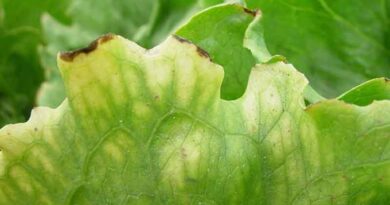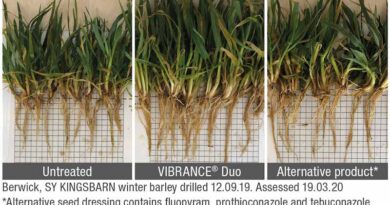Agdia Releases Rapid Molecular Assay for Emerging Cucurbit Pathogen
02 July 2024, Elkhart: Agdia, Inc., a leading provider of plant diagnostic products and services, is happy to announce the introduction of an assay for detection of Cucurbit aphid-borne yellows virus on their popular AmplifyRP® XRT platform.

Cucurbit aphid-borne yellows virus (CABYV) is a Polerovirus of emerging importance to cucurbit growers worldwide. This virus was initially characterized in France in 1992 and has since spread to regions of cucurbit production around the world, resulting in yield reductions of up to 50% during severe outbreaks. Surveys indicate that CABYV is one of the most widespread viruses infecting cucumbers throughout European greenhouses and has seemingly been present in Asia and the Mediterranean basin for several decades (Figure 1.). Limited, yet concerning outbreaks of CABYV have occurred in Africa, South America and the U.S. High disease incidence, wide host range, virulence and vector ubiquity have combined to make CABYV a significant concern for global cucurbit production.
In addition to most cultivated species of cucurbits, CABYV is known to infect beet, chickpea, faba bean, lettuce, passionfruit and tomato. Moreover, several weedy species in Amaranthaceae, Brassicaceae, Chenopodiaceae, Lamiaceae and Malvaceae function as virus reservoirs in the absence of cultivated hosts. Symptoms of CABYV infection on cucumbers, squash and melons can vary depending on host species and variety but typically include leaf yellowing and interveinal chlorosis (Figure 2.). Some varieties experience chlorosis exclusively on the older leaves, whereas others might display yellowing of the entire plant. Symptomatic leaves become thickened and brittle over the course of the season. This virus does not typically affect the quality of the fruit; however, CABYV can cause flower abortion, reducing the number of fruit produced on each plant. Moreover, the fruit that develop can become atypically larger, reducing marketability.

Symptoms of CABYV infections are similar to those caused by nutrient imbalance and several additional viruses prevalent in cucurbits, including the whitefly-transmitted criniviruses Cucumber yellow stunting disorder virus (CYSDV), Beet pseudo-yellows virus (BPYV) and Cucurbit chlorotic yellows virus (CCYV). Moreover, mixed infections with the Potyvirus Watermelon mosaic virus (WMV) are common. In combination, these make the analysis of symptomology complicated and diagnostically imprecise.
Cucurbit aphid-borne yellows virus is phloem-limited and spread by at least three insect vectors in a persistent circulative manner: Aphis gossypii (cotton aphid, Hemiptera), Macrosiphum euphorbiae (potato aphid) and Myzus persicae (green peach aphid). Aphids acquire the virus by feeding on the phloem of infected plants via their stylet mouthparts. The acquisition period can take from several hours to multiple days. Thereafter, the virus circulates throughout the insect’s hemolymph, eventually proliferating in the accessory salivary glands. This process can take up to three days and is requisite for transmission to a healthy plant to occur via feeding activity. Transmission time via feeding is comparable to that of acquisition. Cucurbit aphid-borne yellows virus does not replicate within the aphid, nor can it be passed to offspring; however, viruliferous aphids remain so for life.

It is well documented that plant viruses interact with plant hosts and insect vectors simultaneously, manipulating both to facilitate the most efficient virus acquisition and transmission. Research shows that the behavior of the most efficient vector of CABYV, the cotton aphid, is altered indirectly via changes in the shared host plant (Figure 3.). Viruliferous aphids show a distinct preference for healthy plants, whereas non-viruliferous aphids spend longer feeding on infected plants versus healthy plants. In combination, this manipulation of the disease cycle by CABYV facilitates its own most efficient acquisition and transmission. Cucurbit aphid-borne yellows virus is not transmitted mechanically nor is it known to be seedborne.
Successful management of CABYV in fields and greenhouses is complex, utilizing multiple strategies, including exclusion of virus sources and vectors, vector management and disruption of vector activities. Genetic resistance has been identified in cucurbit spp.; however, the resistance genes in crops other than melon have not been characterized and are not commercially available.

Accurate and timely diagnosis of plants infected with viruses is paramount to successful management throughout the growing season, including the establishment and transplanting phases. And Agdia’s new AmplifyRP® XRT assay for detection of Cucurbit aphid-borne yellows virus provides growers from multiple cropping systems with varying levels of expertise with a powerful diagnostic tool. AmplifyRP® XRT technology promotes the rapid amplification and detection of nucleic acid targets, DNA or RNA, while maintaining a single operating temperature of 42oC. The AmplifyRP® XRT products achieve target sensitivity and specificity comparable to qPCR while having clear advantages over the lab-based technology. AmplifyRP® XRT products do not require a nucleic acid purification step, as crude sample extracts are prepared using a simple extraction buffer and tested directly. When paired with Agdia’s AmpliFire® isothermal fluorometer, the XRT system is a rapid, user-friendly tool that can be implemented in the field or the lab by personnel with limited experience in molecular diagnostics (Figure 4.).
Agdia states their new assay for CABYV will detect several known isolates from around the world. Moreover, the assay was validated against a comprehensive panel of potential cross reactors, including viruses known to infect cucurbits and cause similar symptomology. The only cross reactor identified was Melon aphid-borne yellows virus. This product was developed to be used with leaf, petiole and stem tissue. Please see Agdia’s product page to access a comprehensive validation report. The introduction of Agdia’s new AmplifyRP® XRT assay expands their catalog to 28 products on this platform.
As a leading provider of diagnostic solutions for agriculture, Agdia, Inc. has been serving plant breeders, propagators, growers, universities, regulatory organizations and private testing laboratories since 1981. The company offers a comprehensive portfolio of validated, easy-to-use diagnostics for identifying plant pathogens, plant hormones, and transgenic traits and comprehensive customer support on all products. In addition, Agdia operates an ISO accredited, in-house, testing services laboratory. For more information on Agdia’s full line of products and services, visit the company’s website at www.agdia.com, e-mail info@agdia.com, phone 1-574-264-2615 (toll-free 800-622-4342) or fax 1-574-264-2153.
(For Latest Agriculture News & Updates, follow Krishak Jagat on Google News)
(+80 Million Farming Audience Visits Krishak Jagat’s Hindi Website – Click Here for Website)















